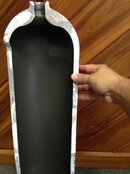Scubadude_LA
Contributor
- Messages
- 344
- Reaction score
- 69
- # of dives
- I just don't log dives
I was under the impression that a hydro facility must condemn any tank that failed hydro and that vis was another issue. For example, a steel tank failing VIS that needs a tumble, followed by a hydro and then all good. VIS is a scuba industry thing not DOT if I'm correct.
But I think VIS lacks safety, IMO many VIS inspections at many shops aren't worth squat, drop a light, yeah looks ok (according to part time college student), new valve o-ring maybe, and slap on a sticker and pump to 3200 for a cool down and a $10 sticker fee. This is good in a way since any flooding, mass corrosion, etc should be spotted.
I think AL tanks should require eddys more often due to sustained load crackingk but that could lead to a great deal of false positives too. Unless grossly abused, seems like steels are more forgiving.
Disclaimer: Don't trust everything you read on the internet...
Edit: If we really are concerned and are somewhere and see some nasty looking tanks, shoot a pic, spread awareness. The pics I posted were no where near the worst in the bunch on that trip. In hindsight, I hope there were no incriminating markings on an otherwise ok tank that just looked tired, just trying to make us aware. But I think it can be an issue over and above explosions, like clogging of 1st stage filters, etc.
But I think VIS lacks safety, IMO many VIS inspections at many shops aren't worth squat, drop a light, yeah looks ok (according to part time college student), new valve o-ring maybe, and slap on a sticker and pump to 3200 for a cool down and a $10 sticker fee. This is good in a way since any flooding, mass corrosion, etc should be spotted.
I think AL tanks should require eddys more often due to sustained load crackingk but that could lead to a great deal of false positives too. Unless grossly abused, seems like steels are more forgiving.
Disclaimer: Don't trust everything you read on the internet...
Edit: If we really are concerned and are somewhere and see some nasty looking tanks, shoot a pic, spread awareness. The pics I posted were no where near the worst in the bunch on that trip. In hindsight, I hope there were no incriminating markings on an otherwise ok tank that just looked tired, just trying to make us aware. But I think it can be an issue over and above explosions, like clogging of 1st stage filters, etc.





